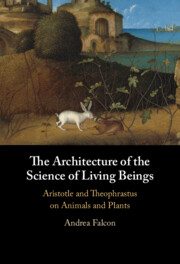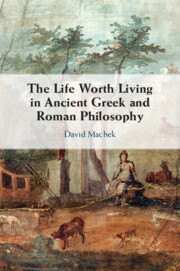118 results
Chapter 3 - Pre-explanatory and Explanatory Strategies in Aristotle’s Study of Animals
-
- Book:
- The Architecture of the Science of Living Beings
- Published online:
- 30 May 2024
- Print publication:
- 06 June 2024, pp 77-120
-
- Chapter
-
- You have access
- Open access
- HTML
- Export citation
Chapter 6 - The Invention of Biology?
-
- Book:
- The Architecture of the Science of Living Beings
- Published online:
- 30 May 2024
- Print publication:
- 06 June 2024, pp 187-208
-
- Chapter
-
- You have access
- Open access
- HTML
- Export citation
Chapter 1 - Aristotle’s De anima and the Study of Perishable Living Beings
-
- Book:
- The Architecture of the Science of Living Beings
- Published online:
- 30 May 2024
- Print publication:
- 06 June 2024, pp 15-45
-
- Chapter
-
- You have access
- Open access
- HTML
- Export citation
Chapter 2 - Aristotle’s Parva naturalia and the Study of Animals and Everything That Has Life
-
- Book:
- The Architecture of the Science of Living Beings
- Published online:
- 30 May 2024
- Print publication:
- 06 June 2024, pp 46-76
-
- Chapter
-
- You have access
- Open access
- HTML
- Export citation

The Architecture of the Science of Living Beings
- Aristotle and Theophrastus on Animals and Plants
-
- Published online:
- 30 May 2024
- Print publication:
- 06 June 2024
-
- Book
-
- You have access
- Open access
- Export citation
Chapter 1 - The Life
- from Part I - Life and Times
-
-
- Book:
- Goethe in Context
- Published online:
- 16 May 2024
- Print publication:
- 23 May 2024, pp 9-19
-
- Chapter
- Export citation
Introduction
-
-
- Book:
- Goethe in Context
- Published online:
- 16 May 2024
- Print publication:
- 23 May 2024, pp 1-6
-
- Chapter
- Export citation
Introduction
-
-
- Book:
- The Cambridge Companion to William Morris
- Published online:
- 03 May 2024
- Print publication:
- 23 May 2024, pp 1-12
-
- Chapter
- Export citation
Chapter 5 - Forms of Artefacts as Inert and Intermittent
-
- Book:
- Aristotle's Ontology of Artefacts
- Published online:
- 14 December 2023
- Print publication:
- 21 December 2023, pp 150-180
-
- Chapter
- Export citation
Better than nothing: On defining the valence of a life
-
- Journal:
- Economics & Philosophy , First View
- Published online by Cambridge University Press:
- 07 November 2023, pp. 1-28
-
- Article
-
- You have access
- Open access
- HTML
- Export citation
11 - Civic and Anti-Civic Ethics
- from Part II - Thought
-
-
- Book:
- The Cambridge Companion to the Sophists
- Published online:
- 23 December 2023
- Print publication:
- 19 October 2023, pp 306-334
-
- Chapter
- Export citation
Chapter 4 - Aristotle’s Defence of Natural Teleology
-
- Book:
- True Purposes in Hegel's Logic
- Published online:
- 16 May 2023
- Print publication:
- 27 April 2023, pp 60-78
-
- Chapter
- Export citation
Conclusions
-
- Book:
- The Life Worth Living in Ancient Greek and Roman Philosophy
- Published online:
- 29 April 2023
- Print publication:
- 27 April 2023, pp 224-232
-
- Chapter
- Export citation
Chapter 6 - Plotinus on the Worth of Embodied Existence
-
- Book:
- The Life Worth Living in Ancient Greek and Roman Philosophy
- Published online:
- 29 April 2023
- Print publication:
- 27 April 2023, pp 195-223
-
- Chapter
- Export citation
Chapter 8 - The Immediate Actuality of Purposes
-
- Book:
- True Purposes in Hegel's Logic
- Published online:
- 16 May 2023
- Print publication:
- 27 April 2023, pp 168-202
-
- Chapter
- Export citation
Chapter 3 - Decoupling Happy Life from Life Worth Living in Stoicism
-
- Book:
- The Life Worth Living in Ancient Greek and Roman Philosophy
- Published online:
- 29 April 2023
- Print publication:
- 27 April 2023, pp 99-134
-
- Chapter
- Export citation
Chapter 2 - Aristotle on the Natural Goodness of Life
-
- Book:
- The Life Worth Living in Ancient Greek and Roman Philosophy
- Published online:
- 29 April 2023
- Print publication:
- 27 April 2023, pp 63-98
-
- Chapter
- Export citation

The Life Worth Living in Ancient Greek and Roman Philosophy
-
- Published online:
- 29 April 2023
- Print publication:
- 27 April 2023
Chapter 1 - Plato on Making Life Worth Living by Doing One’s Job
-
- Book:
- The Life Worth Living in Ancient Greek and Roman Philosophy
- Published online:
- 29 April 2023
- Print publication:
- 27 April 2023, pp 34-62
-
- Chapter
- Export citation
Chapter 4 - Threshold Nears the Target: Hellenistic Hedonists on the Life Worth Living
-
- Book:
- The Life Worth Living in Ancient Greek and Roman Philosophy
- Published online:
- 29 April 2023
- Print publication:
- 27 April 2023, pp 135-163
-
- Chapter
- Export citation



